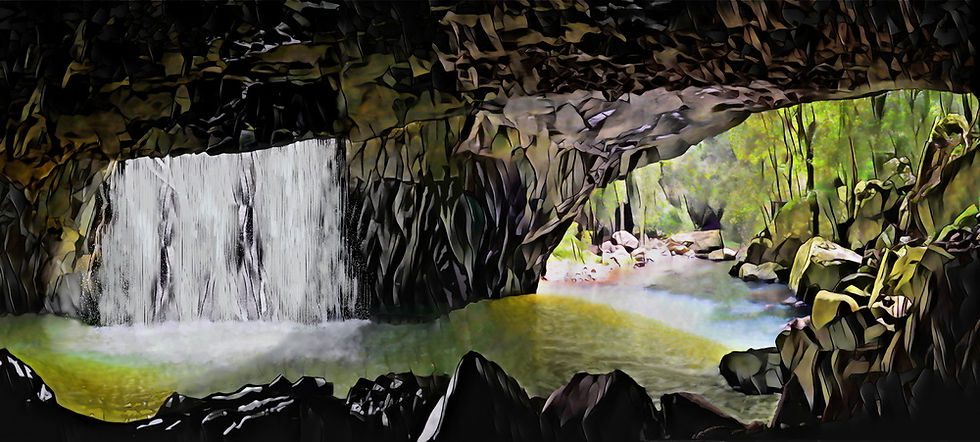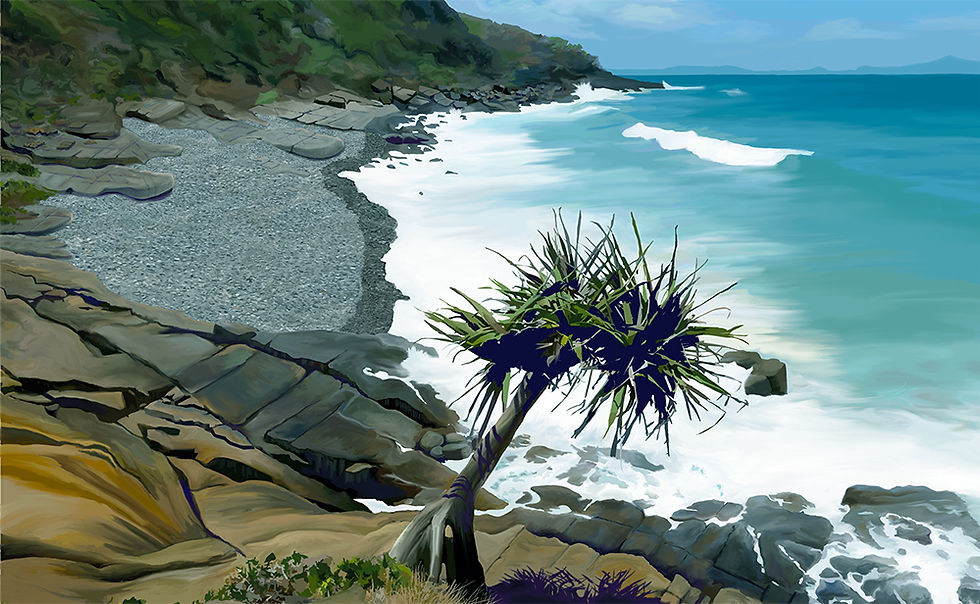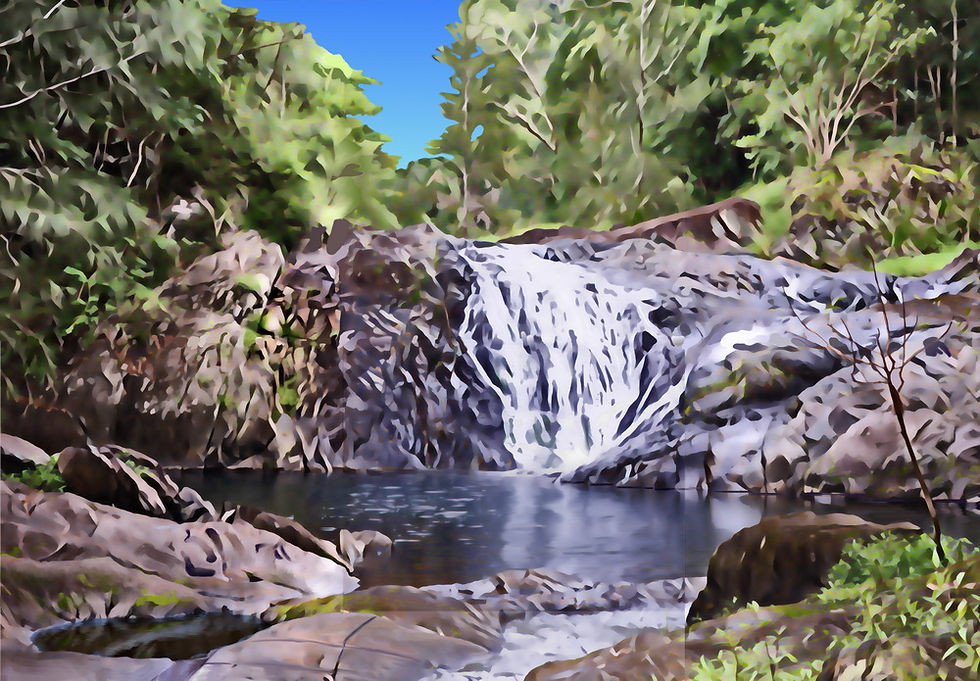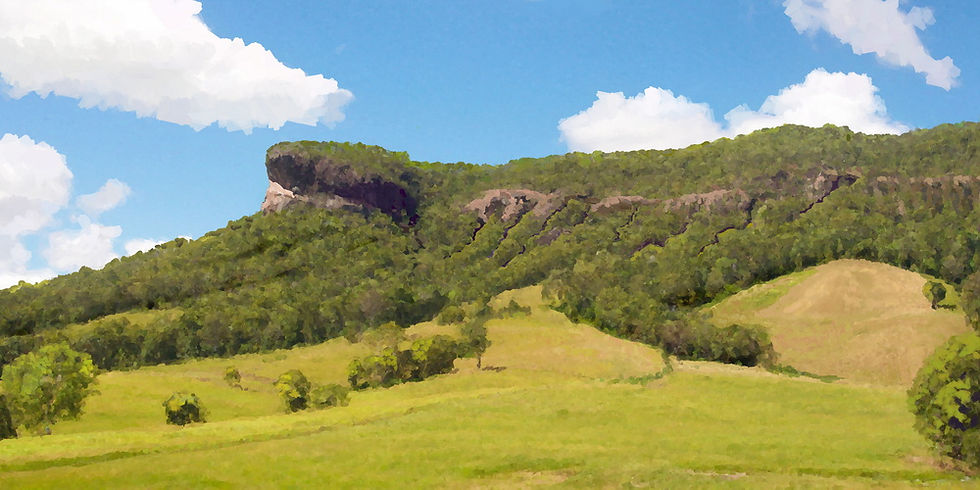LIMITED-EDITION PRINTS WITH A GEOLOGICAL FOCUS
Prints with a geological focus represent artwork inspired by the beauty of natural environments where geology has contributed significantly to the appeal. The digital paintings created are based to a large extent on the beautiful Sunshine Coast region of Queensland. All of the features in the paintings are intrinsically beautiful; most could even be described as spectacular.
Brief descriptions that are provided below with each print summarise the geological processes that have given rise to features that are central to the paintings.
(Click on any image to see a larger version. Please note that digital art images on these pages are subject to Copyright and may not be downloaded or copied in any form.)

Canvas size 102 cm x 71 cm

Canvas size 102 cm x 61 cm

Canvas size 102 cm x 46 cm

Canvas size 92 cm x 61 cm

Canvas size 102 cm x 61 cm

Canvas 102 cm by 71 cm

Canvas 102 cm by 51 cm
Coonoowrin
Mount Coonowrin, also known as Crookneck, is a volcanic plug within the Glass House Mountains. Volcanic activity about 27 million years ago formed a shield volcano centred on the Glass House Mountains and with its flanks extending at least as far as Maleny-Montville, Buderim, and Mount Mee to the north, northeast, and south respectively. Mount Coonowrin is composed of a variety of the rock type rhyolite that formed when lava congealed in a volcanic conduit within the shield volcano.
Erosion during the last 27 million years has stripped away much of the shield volcano in the Glass House Mountains region; plugs such as Mount Coonowrin remain as prominent peaks because of their comparative resistance to erosion. A dramatic shape with interesting viewing from several different angles makes this plug spectacular.
-
Coonoowrin is printed on canvas, stretched over a wooden frame
-
Large prints: canvas dimensions 102 cm x 71 cm
-
Limited edition prints (25 in total) are individually signed and numbered by the artist
Coolum cooling columns
Mount Coolum is a dome-shaped body composed of a variety of the rock type rhyolite that intruded the sandstones of the area about 28 million years ago. The magma (molten rock material) probably did not reach the land surface at that time before solidifying; the dome has been exposed by erosion of overlying sandstones and is now a prominent feature because the rhyolite, after being unroofed, resists erosion more strongly than the surrounding sandstones.
Mount Coolum rises about 200 metres above the surrounding terrain with a distinctive and attractive shape. Spectacular cooling columns, resulting from shrinkage after solidification of the magma at about 700-800 degrees Centigrade, can be observed at several places on the mountain. Late afternoon sun highlights the most prominent columns in the disused quarry.
-
Mount Coolum is printed on canvas, stretched over a wooden frame
-
Large prints: canvas dimensions 102 cm x 61 cm
-
Limited edition prints (25 in total) are individually signed and numbered by the artist
Natural Bridge
Springbrook plateau is a remnant of the northern side of a once huge shield volcano that dominated the region about 23 million years ago. The landscape has been modified by erosion since the volcano became extinct.
Natural Bridge is a rock arch over Cave Creek in the Numinbah Valley. It was formed when a waterfall undercut ancient basalt flows to form a cave behind the waterfall while also wearing a large pothole on top. Erosion continued until the two joined, enabling the creek to now flow through the cave, leaving a natural arch across the front.
-
Natural Bridge is printed on canvas, stretched over a wooden frame
-
Large prints: canvas dimensions 102 cm x 46 cm
-
Limited edition prints (25 in total) are individually signed and numbered by the artist
Arkwright
The headland at Point Arkwright is composed mainly of sandstone layers that were deposited 180-190 million years ago in broad river valleys by streams that typically developed shallow, interlacing channels (braided streams).
Some differences in makeup of the separate sandstone layers as they hardened with burial in the Nambour Basin are now expressed through variable responses to weathering and erosion in today's environment. This makes some layers more prominent that others, giving character to the rugged headland. Brown-coloured material caused by the breakdown of small amounts of iron-bearing minerals in the sandstones stains the surfaces in varying degrees to enhance the natural beauty.
-
Arkwright is printed on canvas, stretched over a wooden frame
-
Large prints: canvas dimensions 91 cm x 61 cm
-
Limited edition prints (25 in total) are individually signed and numbered by the artist
Granite Bay
The Granite Bay section of the coastal track eastwards from the Noosa National Park entrance differs geologically from the remainder of the walking track in that it passes over an igneous intrusion of granitic rock (strictly quartz diorite). The granitic outcrops are best seen along the shore in Granite Bay, at the back of a beach that is spectacularly composed largely of rounded grey boulders that darken in colour when wetted by waves.
Most of the rounded boulders are derived from the sandstone layers adjacent to the intrusion. Heat from the granitic magma when it was emplaced in these sandstones about 145 million years ago affected the surrounding sandstones (changing them to the rock type quartzite), thereby toughening the original material such that rounded grey boulders of quartzite continue to survive in abundance on the beach despite battering by waves.
-
Granite Bay is printed on canvas, stretched over a wooden frame
-
Large prints: canvas dimensions 102 cm x 61 cm
-
Limited edition prints (25 in total) are individually signed and numbered by the artist
Artists Cascades
Some of the oldest rocks in the Sunshine Coast region are exposed along Booloumba Creek south-west of Kenilworth. These rocks, initially deposited some 350 million years ago as muds and submarine volcanics on an ancient deep ocean floor, have undergone a complex history of crumpling and fracturing under pressure and being uplifted to mountains that have subsequently worn down substantially over long periods of geological time.
As Booloumba Creek winds through the Conondale National Park, one of the scenic places where these old rocks are well exposed is Artists Cascades.
-
Artists Cascades is printed on canvas, stretched over a wooden frame
-
Large prints: canvas dimensions 91 cm x 61 cm
-
Limited edition prints (25 in total) are individually signed and numbered by the artist
Duwirri
Duwirri, also known as Brooloo Bluff, is a prominent bluff visible from the Mary Valley Road about 10 km north of Kenilworth. Duwirri, with its spectacular overhang, lies at the northern end of a mountain mass rising about 500 metres above surrounding valleys and known (escpecially at the southern end facing Kenilworth) as Kenilworth Bluff.
The mountain mass containing Duwirri is part of the North Arm Volcanics that crop out extensively in the region Eumundi-Kenilworth-Nambour-Yandina. These rocks formed as a result of eruptions, many of which were highly explosive, about 213 million years ago. Fragmental rock material generated by explosive eruptions produced thick sheets that were sufficiently hot to compact and harden under their own weight, forming welded tuffs. Rhyolite lava flows were also poured out during the volcanic activity.
Sunlight striking Duwirri just below its precipitous overhang highlights the orange colours of fresh surfaces. Elsehere on the mountain the rocks are mainly stained in brown tones.
-
Duwirri is printed on canvas, stretched over a wooden frame
-
Large prints: canvas dimensions 102 cm x 51 cm
-
Limited edition prints (25 in total) are individually signed and numbered by the artist

